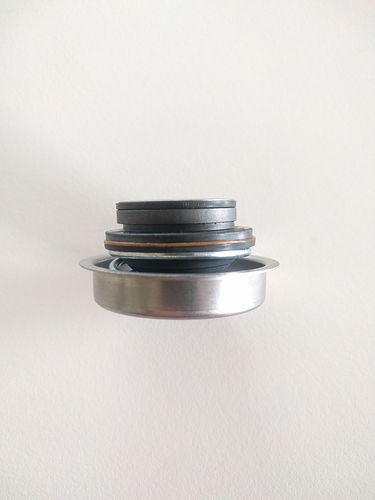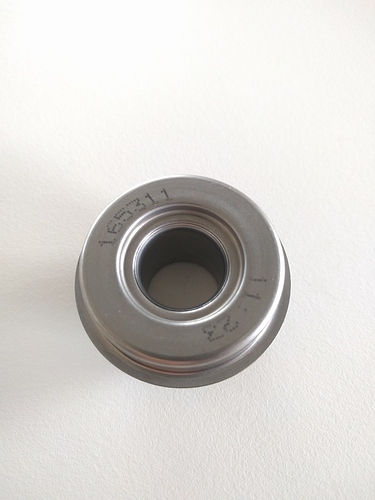Difference is OD. Trial fit before assembly. It will either be correct or way off. Should be obvious. We include both seals in our kits.
Does that mean that bearings are different as well?
from the picture, you have a later V12 pump although I never saw which year. The 1971-1972 pumps use a different bearing. From 1973 on, all the same bearing.
That doesn’t sound right at all. The seal is spring-loaded and is supposed to be compressed a bit when installed. There shouldn’t be a gap.
Sometimes experience is the best teacher. Might be time to get some.
Heh heh…Kirby has a whole BOOK full of experience…that he has kindly shared with we XJS owners…in addition to the stuff he has accumulated outside of fiddling with Jaguars…
And…I suspect he is right about mechanical seals on a water pump…they normally have a rotating piece of ceramic pushing on a stationary piece of ceramic to achieve the rotating seal…and yes…you guessed it…a spring provides the force to achieve a higher pressure in the ceramic joint than is inside the pump casing to stop the water from departing.
We are talking here with Dick about different thing, we know that there should be spring pressure for the seal to work. Question is how much more sprig pressure should be applied while assembling as those seals come already preassembled so you already have initial spring pressure.
The seals come preassembled with a set amount of preload with the spring. If you push on the impeller to the point where it hits the seal IE: no gap as Kirbert says, that is fine as long as your vane to housing gap is in specs. If you end up having to push the impeller further which in turn further compresses the seal, it might be OK or it might have to much preload and be short lived. Leaving a gap between the impeller and the seal is the best way as you can set the impeller gap properly and not effect the seal. I am well aware of Kirberts book as I am even quoted and mentioned in it. However, I have also done a few thousand pumps at this point and have yet to have a warranty on any V12 pump. If there is not supposed to be a gap between the impeller and the seal, then how do you set the vane gap without disturbing the seal preload. I am all ears waiting on an answer. Maybe I have been doing it wrong all this time.
You don’t have to worry about the preload too much. If the seal makes use of ceramics…which I am assuming…then the TINY difference in contact pressure with the clearances you are playing with will not make any difference. The spring is relatively soft…the clearances you are playing with are very small…and the ceramic is INCREDIBLY tough and wear resistant…with maximum compressive stresses between 30 and 100 TIMES higher than mild steel. The difference you will make to the compressive stress in the contact faces will be lost in the noise.
If you’ve been machining the impeller, I think you’ve been doing it wrong all this time. IIRC, the seal land is a metal ring that sits up against the impeller with a rubber collar that effectively seals it against the shaft and the impeller. The body of the seal is pressed into the housing and features a spring holding the running face – which is carbon or ceramic, very narrow contact surface – and the spring is surrounded by a rubber sleeve that flexes as the spring is compressed. When assembled, that spring should be compressed to somewhere in the middle of its range. There should be no gaps anywhere in that seal assembly. The only gap involved is the gap between the impeller itself and the housing, which you set by how far you press the impeller onto the shaft.
Sorry for the confusion. We use the modernu unitized seal (one piece) that is self contained. It does use ceramic seals spring loaded to each other and is already assembled and preloaded. This is what the usuals sell in the rebuild kits. The kind of seal you are referring to is the old style and it did seal agaisn’t the impeller with spring loading. I was not aware of anyone still using this type of seal as it can be troublesome if not done right and set right. I do see this type of seal in the V12 pumps that come in for rebuilding but it is usually old pumps that have never been rebuilt in the recent past.
Can you post a photo of this seal?
I am off work until Monday so it will be a few days. However, I found one for sale on EBAY. Search EBAY with number 311624621923 This is just one size. There are probably 20 sizes of this style seal.
Thanks. Still looks like the spring is supposed to be compressed, though. What seals the rotating part against the shaft?
Here’s a picture of the seal:
There is some preload on the spring as to parts are preassembled. But the spring can be compressed further more ~2,5mm. It is obvious that spring should be compressed further more just so the two metal parts don’t touch, but how much?
The rotating part or the center has a sleeve that seals on the bearing shaft. We use a Loctite product to assure the seal. We do press the seal a bit tighter. I have seen then where the impeller further presses them tighter after assembly to the point of binding. This means taking the pump apart and starting over with some of the metal machined off of the impeller.
I still don’t see how that inner sleeve seals on the shaft. It looks like bare metal in the photo.
If the total spring travel is 2.5mm, I’d be looking to compress it 1-1.5mm. Yeah, if assembly overcompresses it to the point of binding, you’d need to machine the impeller, but I’d be suspicious that something was wrong by that point. I would think the tolerances in the design were intended to land you in the middle of that 2.5mm, and overcompressing would be a sign that something was assembled incorrectly.
Not all of the pumps were originally designed to use the unitized seal. The replacement impellers are designed to work with the modern seals. Old impellers need to be machined in most cases. The inner sleeve is bare metal. I mentioned we use a Loctite product to seal it.
It just seems odd to me that the original design seal with its rubber seat would be “updated” to a design that requires Loctite as a primary sealing method.
It also strikes me as odd that an updated seal design would require machining of the impeller. If I were the engineer designing the new seal, I’d design it to fit exactly where the old one did.
Kirby, i would say that Jaguar used the GM tapered shape of impeller design , Chevy V8 pumps came out in 1955!
and i use a cast Bronze diesel impeller from a a 1938 GMC industrial engine , slightly modified to fit tighter, in the 1978 Jag V12 pump housing! been runnin for 25yrs, i use the seal like shown in pix(jon,jon,) only difference is new seal has a SS case,as old one was a brass case!
ron


